Farbrengen: a Gathering of Images
A farbrengen is a gathering of Hassidism in the presence of their holy Rebbe tolearn Torah and hear his words of wisdom. This exhibition is such a gathering. The hitherto unseen photographs by the photographer Jerry Dantzic present the collective fabric and texture of the Lubavitch community. The torah life of a hasid is seen in a joyous wedding dance, tender moments at the b’deckening and under the chuppah, a l’chaim to the Rebbe and rapt attention at leining on Purim morning.
What can these photographs teach us? The similar subjects framed by an empathetic point of view and, paradoxically, a certain distance begin to shape a working definition of the photojournalist. That definition is accepted with pride by Jerry Dantzic whose photographs from 1972-1973, Farbrengen, are currently at the Chassidic Art Institute until April 27, 2003.
Dantzic has worked as a professional photographer based in his Brooklyn studio since 1954. The recently published, Jerry Dantzic’s New York: The Fifties in Focus (Edition Stemmle, 2002) reveals the astonishing scope of his work covering almost every aspect of New York neighborhoods and street life; including Chinatown, Little Italy, Coney Island, Manhattan jazz spots and nightclubs, CBS recording studios, New Years Eve Times Square, digging the Lincoln Tunnel and opening night at the Metropolitan Opera. His lifetime of work as a commercial photographer is paralleled by a passionate love affair with New York and America. His son, Grayson Dantzic, has devoted the last four years to publicizing and publishing his father’s vibrant images of his beloved city. This exhibition presents previously unprinted work documenting Crown Heights.
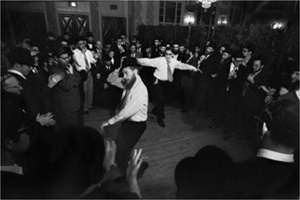
Wedding Dancers (1973) captures the joy and exuberance a simcha brings to our hearts. The intensely physical gestures of the two men clad in white shirts against a sea of black jackets sweeps through the image at a breakneck pace fueling the rhythmic clapping of the onlookers who are about to join in. The man in the foreground clapping becomes the visual surrogate for the viewer, drawing us into the action.
Dantzic’s ability to be simultaneously involved with his subjects and yet an objective observer is precisely the quality that allows him to become invisible in the midst of the intensely private world of the Lubavitch Hasidim. In late 1972 he began working on a documentary on the “White Ethnics of America.” He had lived in Crown Heights from 1962 until 1968 and was somewhat familiar with the community. Through a friend he managed to obtain permission from the Lubavitch to openly photograph the community over the period of the next two years. They were very taken with his warm personality and he responded in kind. He was given complete access.
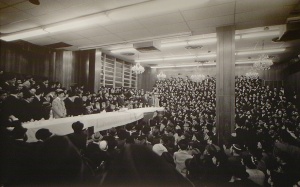
At a Farbrengen in 1973 one joins the rapt audience that fills the room to overflowing, seeming to ascend the very walls themselves. This image is the result of dozens of shots he took at that event, shooting away, frequently four or five a minute, until he had captured the crystallizing moment that would condense the experience into one or two potent images.
Dantzic’s desire to capture and bring together disparate visual phenomena led him to pursue an entirely different kind of photography at about the same time. In 1972 he became interested in an antique panoramic camera, the Cirkut camera, that had been developed at the turn of the century. He began working with the dramatic new equipment that allowed him to photograph in color and exacting detail a panoramic scene extending over 360 degrees. The prints are as much as six feet long. Finally in 1977 he obtained a grant from the National Endowment for the Arts and traveled through thirty states for over one hundred days of shooting to document America’s cities, historic sites and landscapes. The result was a one-man show at the Museum of Modern Art in 1978. Effectively he was creating his own visual record of the country, “my own legend of America” in which the radical extension of vision brings the element of time into the process. A distinct sense of past and future combined in one paradoxically static image emerges in the gathering of views taken in a fifteen second shot.
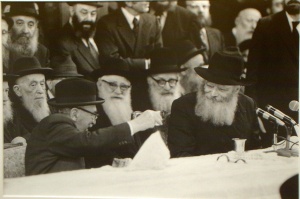
Not all of his images attempt to gather in the disparate. President Zalmen Shazar of Israel toasting the Rebbe (1973) narrows the focus to the joy and satisfaction of Torah giants viewing the meeting of religious and political worlds. The composition is delicately balanced, resting on the fulcrum of a white triangular napkin. The l’chaim cup activates the entire image as everything from the Rebbe, the President and the sages behind them is captured in its blessing.
The photojournalism of Jerry Dantzic is distinct from art photography. Ben Lifson in his forward to The Fifties in Focus captures Dantzic’s genius. “The task is not to perfect these lyrical moments, but to capture their familiar excellence; not conspicuously to transfigure characters in life as figures in art, but to keep them embedded in life.” Gathering images together so that they can communicate the essence of the people of New York has been the life work of Jerry Dantzic.
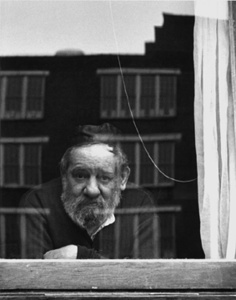
The World Outside (1953) was photographed in Williamsburg, Brooklyn. It seems to simultaneously sum up the role of the photojournalist and the religious Jew in New York. The man behind the window compassionately looks out as if to say, “And what do you think you are doing? Do you think your camera will capture me?” This photograph locates its subject embedded in his life inside, and by the reflection in the window, the life outside in the neighborhood. Closeness and distance are depicted as the photographer and his subject both bear witness to the experience that unfolds between them.
The notion of bearing witness becomes the most powerful dynamic in the exhibition. If nothing else, the photojournalist provides a record of what has occurred and in many cases, by implication, what will occur in the future. Life in Crown Heights today looks remarkably similar to the glimpses we see from thirty years ago. The gentle interchange between Father and Son (1973), with the exception of the style of his hat, defies time and defines parenting well into the future.
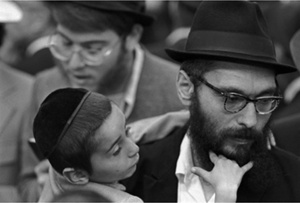
Jerry Dantzic’s photojournalism frequently implies a narrative that is interrupted. Much like his Cirkut Camera panoramas that attempt to collect in one long print disparate views of one place and time in America, so too the narrative that proceeded and continues after his images of Crown Heights implies a life that continues on, sure in its faith and devotion. This exhibition, a gathering of images, affirms a life of holiness that he found in Crown Heights thirty years ago and is still vibrant today.